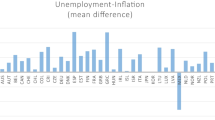Abstract
The increase in human population at large scale has given the birth to the problem of unemployment as industrialization has not taken place in the same proportion. Some developing countries are making efforts for sustainable industrial growth to overcome with this problem. To tackle this problem, in the present paper, we propose a nonlinear mathematical model to study the role of unemployment-dependent industrial growth (geared industrialization) on the control of unemployment. The study of the model is based on using the method of stability theory of differential equations. The study reveals that the sustainable growth of industrialization helps to control the problem of unemployment. Finally, certain numerical calculations have been carried out to support analytical findings.





Similar content being viewed by others
References
Alcorta, L. (2015). Industrialization, employment and the sustainable development agenda. Development, 58(4), 528–539.
Arias, O.S., Sanchez-Paramo, C., Davalos, M.E., Santos, I., Tiongson, E.R., Grun, C., Falcao, N.D.A., Saiovici G., & Cancho C.A. (2014). Back to Work: Growing with Jobs in Europe and Central Asia Reports;. Washington, DC: World Bank. Available at: https://openknowledge.worldbank.org/handle/10986/16570.
Aremu, M. A., & Adeyemi, S. L. (2011). Small and Medium Scale Enterprises as A Survival Strategy for Employment Generation in Nigeria. Journal of Sustainable Development, 4(1), 200–206.
Al-Sheikh, S., Al-Maalwi, R., & Ashi, H. A. (2021). A Mathematical Model of Unemployment with the Effect of Limited Jobs. Comptes Rendus. Mathematique, 359(3), 283–290.
Al-Maalwi, R., Al-Sheikh, S., Ashi, H. A., & Asiri, S. (2021). Mathematical modeling and parameter estimation of unemployment with the impact of training programs. Mathematics and Computers in Simulation, 182, 705–720.
Ayoade, A., Odetunde, O., & Falodun, B. (2020). Modeling and Analysis of the Impact of Vocational Education on the Unemployment Rate in Nigeria. Applications and Applied Mathematics: An International Journal (AAM), 15(1), 550–564.
Bhowmik S. K. (2012). Industry, Labour and Society. Orient Blackswan Private Limited, New-Delhi.
Freedman, H. I., & So, J. W. H. (1985). Global stability and persistence of simple food chains. Mathematical biosciences, 76, 69–86.
Galindro, A., & Torres, D. F. M. (2018). A simple mathematical model for unemployment: a case study in Portugal with optimal control. Stat. Optim. Inf. Comput., 6, 116–129.
Ghose, A. K. (2004). The employment challenge in India. Economic and Political Weekly, 39(48), 5106–5116.
Harding, L., & Neamtu, M. (2016). A Dynamical Model of Unemployment with Migration and delayed Policy Intervention. Computational Economics, 51(3), 427–462.
Hurwitz, A. (1895). On the conditions under which an equation has only roots with negative real parts. Mathematische Annalen, 46, 273–284.
Lata, K., Dubey, B., & Misra, A. K. (2016). Modeling the effects of wood and non-wood based industries on forestry resources. Natural Resource Modeling, 29(4), 559–580.
Misra, A. K., & Singh, A. K. (2011). A mathematical model for unemployment. Nonlinear Analysis Real World Applications, 12(1), 128–136.
Misra, A. K., & Singh, A. K. (2013). A Delay Mathematical Model for the Control of Unemployment. Differential Equations and Dynamical Systems, 21(3), 291–307.
Misra, A. K., Singh, A. K., & Singh, P. K. (2017). Modeling the Role of Skill Development to Control Unemployment. Differential Equations and Dynamical Systems. https://doi.org/10.1007/s12591-017-0405-3.
Murphy, G. C., & Athanasou, J. A. (1999). The Effect of Unemployment on Mental Health. Journal of Occupational and Organizational Psychology, 72, 83–99.
Pathan, G., & Bhathawala, P. H. (2017). A Mathematical Model for Unemployment-Taking an Action without Delay. Advances in Dynamical Systems and Applications, 12(1), 41–48.
Perez C., (2002). Technological revolutions and financial capital: The dynamics of bubbles and Golden Ages (London, Elgar).
Petaratip, T., & Niamsup, P. (2021). Stability analysis of an unemployment model with time delay. AIMS Mathematics, 6(7), 7421–7440.
Riegle, D. W. (1982). The psychological and social effects of unemployment. Amercian Psychologist, 37(10), 1115–1135.
Singh, A. K., Singh, P., & Misra, A. K. (2020). Combating unemployment through skill development. Nonlinear Analysis: Modelling and Control, 25(6), 919–937.
Sundar, S., Tripathi, A., & Naresh, R. (2018). Does unemployment induce crime in society? A mathematical study. American Journal of Applied Mathematics and Statistics, 6, 44–53.
Trabulsi, H. (2019). Industrial Development and Combating Unemployment in Arab Countries. Canadian Center of Science and Education, 12(9), 43–51.
Acknowledgements
The authors would like to thank the reviewers and the editors for their comments and suggestions which contributed to the development of this manuscript.
Author information
Authors and Affiliations
Corresponding author
Additional information
Publisher's Note
Springer Nature remains neutral with regard to jurisdictional claims in published maps and institutional affiliations.
Appendix
Appendix
1.1 A Proof of Lemma 1
We add second and third equations of the model (1), and get
this gives
where \(\delta =\min \{\delta _{1},\delta _{2}\}\).
Above implies
Now, using equation (15) in the first equation of model (1), we obtain
This gives
where
Finally, from the fourth equation of the model (1) and the equation (16), we have
The above inequality implies,
Hence, this proves the lemma.
1.2 B Proof of Theorem 2
We use Lyapunov’s method for global stability to establish this theorem. For this we use the positive definite function:
for some suitably chosen positive constants \(m_{i}'s, i=1,2,3\).
Now differentiate equation (18) with respect to time t along the solution of system (1), we have
Now, \(\frac{dW_{0}}{dt}\) becomes negative definite in region of asymptotic stability \(\Omega _{0}\) provided the following inequalities hold:
From equations (20) and (25), we can choose the positive values of \(m_1=\frac{4\lambda ^2}{\alpha _0\delta _1}\) and \(m_3=\frac{\eta _0\alpha _0}{3\eta ^2},\) respectively. After choosing \(m_{1}>0\) and \(m_{3}>0\) and using inequalities (21), (22) and (24), we may choose the positive value of \(m_2\) as
Hence, \(\frac{dW_{0}}{dt}\) becomes negative definite in the region \(\Omega _{0}\), if the conditions (13) and (14) are fulfilled.
Rights and permissions
About this article
Cite this article
Singh, P.K., Lata, K., Singh, A.K. et al. Modeling the effect of unemployment augmented industrialization on the control of unemployment. Environ Dev Sustain 25, 587–600 (2023). https://doi.org/10.1007/s10668-021-02069-6
Received:
Accepted:
Published:
Issue Date:
DOI: https://doi.org/10.1007/s10668-021-02069-6




